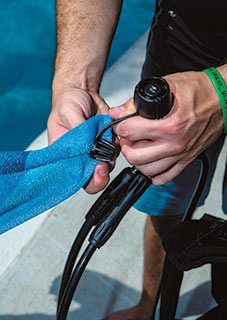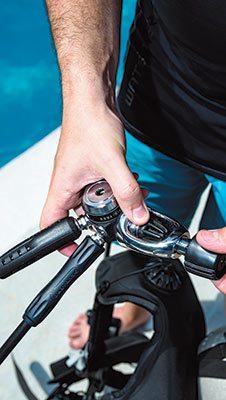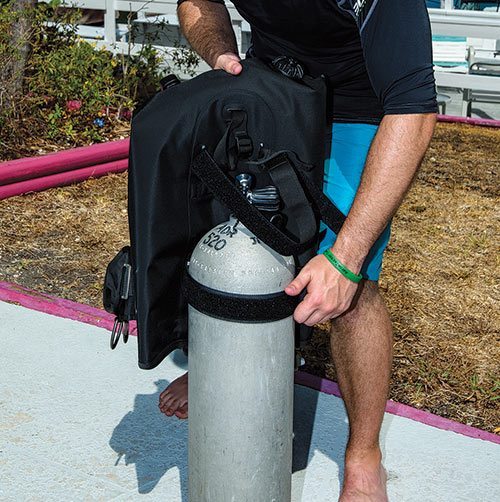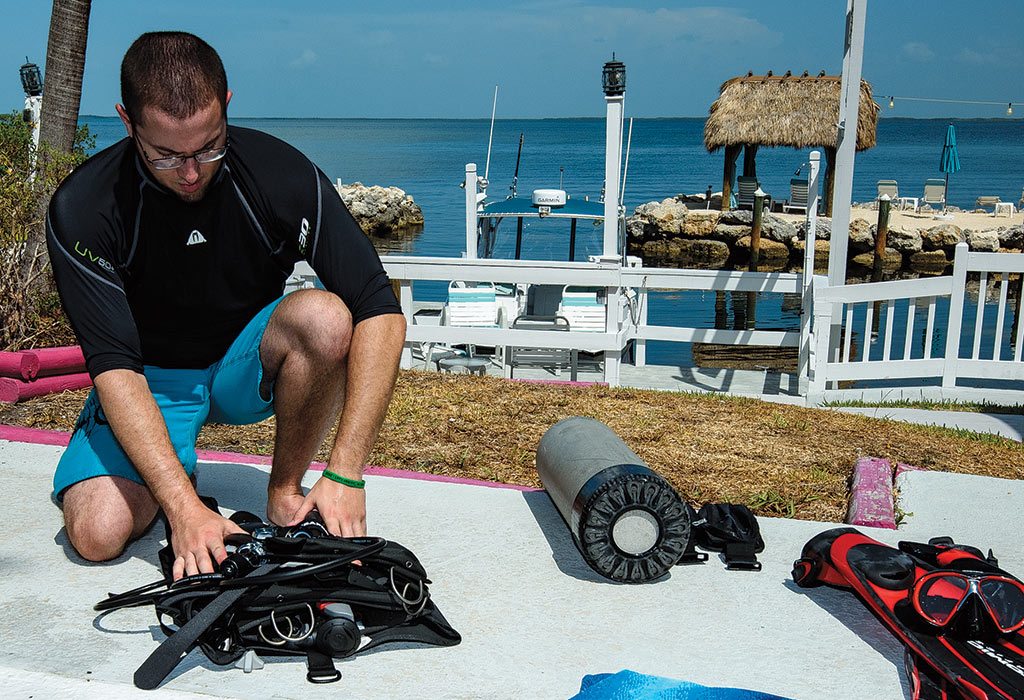How to Setup and Take Apart Scuba Gear UPDATED
How to Setup and Take Apart Scuba Gear
Where, when and exactly how you go about disassembling your scuba unit depends on whether you are diving from shore or a gunkhole and if you are irresolute to a fresh tank betwixt dives or are disassembling the unit to pack away in your gear purse.
When shore diving information technology is best to wear or conduct your scuba unit back to base camp earlier disassembling. Under all circumstances, avoid pulling the unit of measurement across the ground or allowing the second-stage regulators to drag in the sand. Many times it is safest to wear your unit dorsum to the parking area before vehement information technology down; that mode it stays safely off the ground and you lot tin place the disassembled gear directly into your vehicle.
Utilise caution when disassembling the scuba unit on a gunkhole. Typically infinite is at a premium and other divers are doing the same affair y'all are at the aforementioned time, often in tight quarters.
Unless seas are apartment-calm it is best to detach your gear before the boat gets underway for the render trip to shore, or wait until the vessel is secure at the dock. Tearing down a scuba unit on a rocking and rolling gunkhole tin can be challenging, non to mention dangerous.
When disassembling your gear on a boat, try to minimize your footprint. As yous remove the regulator and buoyancy compensator (BC), place them directly in your gear pocketbook; this gets them out of the way of other divers.
Disassembling a scuba unit can best exist accomplished in 5 piece of cake steps.

Step 1
First, position the unit upright on a firm, level surface and if possible, stand behind it. On the beach this might be on the base camp ground cloth; on a boat it is on the swoop deck virtually your gear pocketbook. If the boat has tank racks behind bench seating, every bit is typical on many dive boats, you can consummate this without moving the scuba unit of measurement from the rack.
Steady the unit of measurement with one hand as you close the air valve command knob with the other. Rotate the knob clockwise until it will turn no further, but practice not force it across the natural stopping betoken.
Advertizing


[I] After the air has been turned off, both 2nd-phase regulators need to be depressurized before attempting to remove the beginning phase from the tank valve.
Step two
Even with the air turned off the system is still pressurized. Before the regulator can be removed from the tank valve the system must be purged (Photo i).
Depressing the purge push of both the primary and secondary (condom second) second-stage regulators allows the pressurized air to escape. Keep the buttons depressed until rushing air can no longer be heard.
Now depress the inflate push on the BC'southward inflate/debunk mechanism. This purges the depression-pressure hose. If you are finished diving for the 24-hour interval, you should at present detach the low-force per unit area hose quick disconnect from the BC.
Step iii
With the air valve closed and the system purged, the commencement-phase regulator can hands and safely be removed from the tank valve. Place ane hand on the body of the first-phase regulator and grasp the yoke spiral knob with the other. Be sure to steady the cylinder as you unscrew the knob. Loosen the yoke screw by turning information technology counterclockwise (remember, "left/loose and right/tight"). If you mounted the yoke spiral correctly — simply finger tight — it should turn hands now that the system is no longer pressurized; several turns will allow the regulator to slide forrard and be lifted from the valve.

[Two] After loosening the yoke screw and detaching the first-stage regulator from the tank valve, dry out the dust cover before replacing it.
Earlier continuing, dry the dust encompass using a clean, dry cloth to remove any water aerosol that remain or past carefully positioning the dust cover in front end of the tank valve and gently corking open up the air control knob (Photo 2). Perform this maneuver in such a fashion to avoid blowing water into the air orifice.
Crack the valve but long and wide enough to clear water from the cover. Use caution, nevertheless; thoughtlessly cranking open up the valve for more than an instant tin be abrasive to unsuspecting divers nearby.

[3] Place the dried dust encompass over the regulator's air intake orifice anytime the first stage has been removed from the tank valve, even when you are simply transferring the regulator and BC to a fresh cylinder.
Once the cap is dry, secure it over the starting time-stage regulator'south air inlet opening (Photo 3). Do this whenever you remove the regulator from the tank valve; the dust comprehend prevents water aerosol from entering the starting time stage while y'all are handling it and, fifty-fifty more importantly, eliminates the run a risk that you'll forget to secure the dust comprehend in place before rinsing the regulator.
If the boat is designed with bench seating flanked past vertical tank racks, Step iii tin can be completed without removing the scuba unit from the rack. That may not be the example with Step 4.
Step iv
Before attempting to remove a weight-integrated BC from the cylinder, brand sure the weight pockets accept been emptied of weight. If the tank strap was sufficiently tightened, as it should take been before the swoop, creating sufficient slack to hands slide it off the tank may crave some effort.
BC designs vary from one manufacturer to another, but most feature black plastic buckles where the strap is strung through a series of slots.
Begin by opening the buckle. Free the tail of the strap (information technology often is secured by Velcro) and pull the open stop away from the cylinder and back toward the buckle. Proceed pulling until the buckle snaps open up. This will release some of the tension on the strap, but typically not enough to easily slide the BC upwards and off.
To release additional tension, with the buckle in the open up position unthread the gratuitous end of the strap from the end slot. Now move the buckle back and forth (i.e., ratchet it open and then back toward the closed position). Steady the cylinder with one hand as you grasp the outer edges of the buckle with the other. Push/pull the buckle dorsum past the open up position using a ratcheting motility. Every ratchet will create additional slack until the strap is loose enough to exist easily slid up and down on the cylinder.
Step five
The terminal footstep in disassembling the scuba unit involves physically removing the BC from the cylinder. With the cylinder standing upright on a business firm surface, grasp the BC by the neckband (some models take a sewn-in hand loop at the top) or the acme of the backpack with i hand. Grasp the loosened tank strap with the other manus. Place a leg against the tank to keep it secure and under control.

[Iv] To remove the regulator and BC from the tank, loosen the tank strap and then grasp both the tank strap and the collar of the BC and simultaneously pull upwardly.
With your hands in place, simultaneously lift the BC and the strap until both ascent above the top of the tank valve (Photograph 4). Keeping the strap and the BC level every bit they are raised helps forestall the strap from binding. The boosted force required to costless a binding strap could cause the cylinder to become unstable and increase its trend to tip over.
Once the BC is gratuitous and y'all've removed information technology from the cylinder, without delay secure the cylinder to prevent it from falling and dissentious the valve or possibly injuring someone. If you are at the base camp or on a gunkhole without tank racks, lay the cylinder down or have someone steady it until you tin secure it properly.
If you are on board a boat that has tank racks, place the cylinder in the rack, but do not identify the valve cap back over the tank valve, as this is the standard indication that a tank is full and bachelor for use.
If you are done diving and set to place the BC in your gear bag, plough it upside downwardly and drain any accumulated water from the within. Even better, some boats have rinse buckets where you can requite your regulator and BC a quick dunk before the ride back to shore. Of course, a gunkhole rinse does not eliminate the need to thoroughly rinse your gear once back at the dock.
Switching to a Fresh Tank
With a couple of minor twists, steps i through 4 apply whether y'all are disassembling the scuba unit to pack it away at the stop of the diving twenty-four hours or simply switching the regulator and BC to a fresh tank between dives.
With a fresh tank nearby, turn off the air and purge the system as described earlier. There is no demand to disconnect the low-pressure inflator hose or detach the octopus, as you will exist transferring the regulator and BC equally a unit.
When you loosen the yoke spiral and remove the regulator from the valve, be sure to dry and supplant the dust cover; this prevents h2o from accidentally inbound the regulator'south air intake as y'all transfer the BC. Information technology is a skilful idea to accept the dust cover secure anytime the regulator is not mounted on a tank valve.
Now, go ahead and remove the BC, with regulator still attached, from the used cylinder and transfer it to the fresh one (Photo 5). Secure the BC, mount the regulator and test the system and you're ready to swoop.

[Five] When switching to a fresh tank, the regulator and BC can be transferred as a unit. Be sure to accept the new tank nearby and use caution to avoid leaving either tank continuing unattended during the process.
Story by Lynn Laymon | Photos past Barry & Ruth Guimbellot

DOWNLOAD HERE
How to Setup and Take Apart Scuba Gear UPDATED
Posted by: catherineguall1992.blogspot.com

Comments
Post a Comment